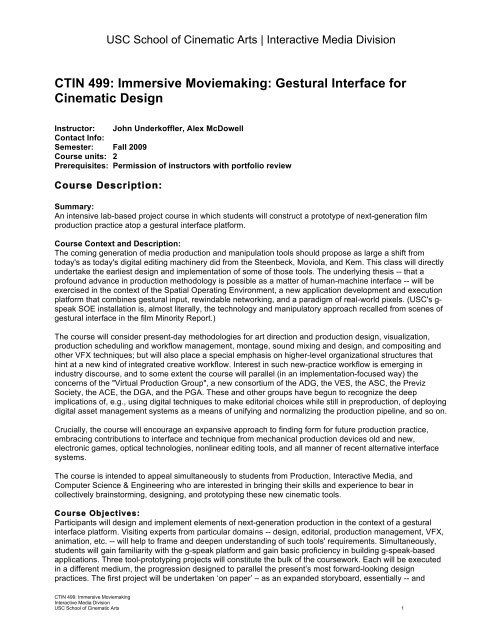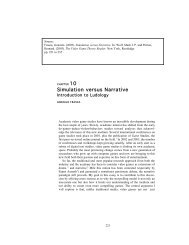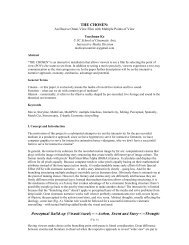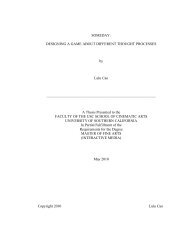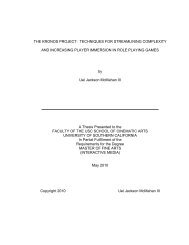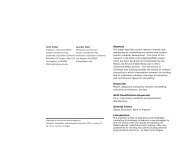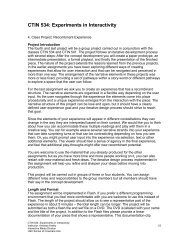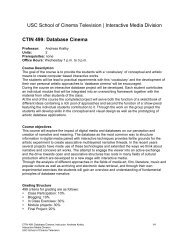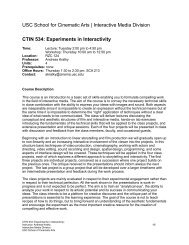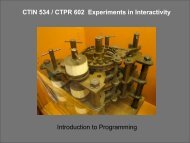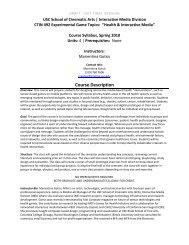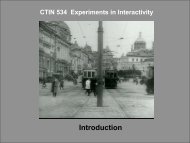CTIN 499: Immersive Moviemaking - USC Interactive Media Division
CTIN 499: Immersive Moviemaking - USC Interactive Media Division
CTIN 499: Immersive Moviemaking - USC Interactive Media Division
You also want an ePaper? Increase the reach of your titles
YUMPU automatically turns print PDFs into web optimized ePapers that Google loves.
<strong>USC</strong> School of Cinematic Arts | <strong>Interactive</strong> <strong>Media</strong> <strong>Division</strong><br />
<strong>CTIN</strong> <strong>499</strong>: <strong>Immersive</strong> <strong>Moviemaking</strong>: Gestural Interface for<br />
Cinematic Design<br />
Instructor: John Underkoffler, Alex McDowell<br />
Contact Info:<br />
Semester: Fall 2009<br />
Course units: 2<br />
Prerequisites: Permission of instructors with portfolio review<br />
Course Description:<br />
Summary:<br />
An intensive lab-based project course in which students will construct a prototype of next-generation film<br />
production practice atop a gestural interface platform.<br />
Course Context and Description:<br />
The coming generation of media production and manipulation tools should propose as large a shift from<br />
today's as today's digital editing machinery did from the Steenbeck, Moviola, and Kem. This class will directly<br />
undertake the earliest design and implementation of some of those tools. The underlying thesis -- that a<br />
profound advance in production methodology is possible as a matter of human-machine interface -- will be<br />
exercised in the context of the Spatial Operating Environment, a new application development and execution<br />
platform that combines gestural input, rewindable networking, and a paradigm of real-world pixels. (<strong>USC</strong>'s g-<br />
speak SOE installation is, almost literally, the technology and manipulatory approach recalled from scenes of<br />
gestural interface in the film Minority Report.)<br />
The course will consider present-day methodologies for art direction and production design, visualization,<br />
production scheduling and workflow management, montage, sound mixing and design, and compositing and<br />
other VFX techniques; but will also place a special emphasis on higher-level organizational structures that<br />
hint at a new kind of integrated creative workflow. Interest in such new-practice workflow is emerging in<br />
industry discourse, and to some extent the course will parallel (in an implementation-focused way) the<br />
concerns of the "Virtual Production Group", a new consortium of the ADG, the VES, the ASC, the Previz<br />
Society, the ACE, the DGA, and the PGA. These and other groups have begun to recognize the deep<br />
implications of, e.g., using digital techniques to make editorial choices while still in preproduction, of deploying<br />
digital asset management systems as a means of unifying and normalizing the production pipeline, and so on.<br />
Crucially, the course will encourage an expansive approach to finding form for future production practice,<br />
embracing contributions to interface and technique from mechanical production devices old and new,<br />
electronic games, optical technologies, nonlinear editing tools, and all manner of recent alternative interface<br />
systems.<br />
The course is intended to appeal simultaneously to students from Production, <strong>Interactive</strong> <strong>Media</strong>, and<br />
Computer Science & Engineering who are interested in bringing their skills and experience to bear in<br />
collectively brainstorming, designing, and prototyping these new cinematic tools.<br />
Course Objectives:<br />
Participants will design and implement elements of next-generation production in the context of a gestural<br />
interface platform. Visiting experts from particular domains -- design, editorial, production management, VFX,<br />
animation, etc. -- will help to frame and deepen understanding of such tools' requirements. Simultaneously,<br />
students will gain familiarity with the g-speak platform and gain basic proficiency in building g-speak-based<br />
applications. Three tool-prototyping projects will constitute the bulk of the coursework. Each will be executed<br />
in a different medium, the progression designed to parallel the present’s most forward-looking design<br />
practices. The first project will be undertaken ‘on paper’ – as an expanded storyboard, essentially -- and<br />
<strong>CTIN</strong> <strong>499</strong>: <strong>Immersive</strong> <strong>Moviemaking</strong><br />
<strong>Interactive</strong> <strong>Media</strong> <strong>Division</strong><br />
<strong>USC</strong> School of Cinematic Arts 1
within the limitations of appropriate static media will serve as a blue-sky concept document describing the<br />
transformation of some particular segment of production workflow. The second will be executed as a video<br />
that demonstrates the interactions central to the transformed workflow segment. The third project will<br />
comprise a nuanced and mature working implementation of a subset of these workflow tasks, and will exploit<br />
the sophisticated HMI capabilities of the g-speak SOE. It is expected that by semester's end the projects,<br />
taken together, will constitute a mature and compelling preview of near-future production methodologies and<br />
an attendant creative workspace.<br />
Curriculum:<br />
This is a course to do with designing and then building things. These activities will occupy the lion's share of<br />
students' overall effort. In-class time will shade from lecture-based (as foundational context is established)<br />
through discussion- and critique-inflected (as proposals for system development are produced and evaluated)<br />
to atelier-style (as construction of final systems proceed). Roughly two-thirds of the class meetings will offer<br />
discipline-specific expertise in the form of guest presentations by exemplary industry practitioners. Readings<br />
will serve an important supplementary role. Readings may be assigned opportunistically.<br />
Team Structure:<br />
After a short series of initial exercises undertaken by students working alone, the course’s major projects will<br />
be executed by three-student teams. It is intended that teams may self-organize to exploit heterogeneous<br />
skills -- separate principal experience in, for example, interaction design, production experience, and graphics<br />
programming -- but other arrangements are fruitfully possible.<br />
Aspects of Reality:<br />
The full breadth of the production pipeline is the domain of this course, and early weeks will be spent partly in<br />
survey of production disciplines. It is not however required (or even really probable) that the collection of team<br />
projects address the pipeline's full span. Participants may elect, for example, to concentrate the teams'<br />
projects in one area in order to experiment with a local ecology of tools. Or the vigorous schedule may<br />
encourage a concentration of tools around some topic especially suited to rapid application development. Or<br />
indeed the class may develop an intuition that, with the right toolset, conditions of self-similarity suddenly<br />
apply: so that a focus on early visualization and planning in a virtual production space may accurately reflect<br />
the full arc of production.<br />
Evaluation of student performance:<br />
Participation 15<br />
Written & Graphical<br />
15<br />
Documents<br />
First Project (System A) 20<br />
Second Project (System B) 20<br />
Final Project (System C) 30<br />
Total: 100<br />
Course content (summarized by class meeting)<br />
Week 1: Primer and Overview<br />
Major interlocking production domains. Visual research and locations; production design; modeling & virtual<br />
construction; visualization; physical construction, prop manufacturing, set decoration; scheduling and<br />
production management; lighting design, cinematography, color grading & timing; script supervision; editorial;<br />
sound design and mixing; VFX.<br />
Introductory look at the Spatial Operating Environment. Basic principles: gestural i/o; real-world pixels;<br />
recombinant networking. The smallest program for the simplest g-speak application. Hands-on exposure to<br />
basic gestural interaction.<br />
<strong>CTIN</strong> <strong>499</strong>: <strong>Immersive</strong> <strong>Moviemaking</strong><br />
<strong>Interactive</strong> <strong>Media</strong> <strong>Division</strong><br />
<strong>USC</strong> School of Cinematic Arts 2
Week 2: Uniting Production Workflow<br />
Domain Expert: Ron Frankel, founder, Proof Inc.;<br />
David Morin, <strong>Media</strong> & Entertainment <strong>Division</strong>, Autodesk<br />
The social, financial, organizational, and technological forces leading to a more integrated workflow. Virtual<br />
production space as venue for early-schedule migration of creative decision-making.<br />
Critical analysis of 'TAMPER' installation as model of future rapid-assembly (compositing) workstation.<br />
Introduction to character-based GRIPE symbolism for hand-pose representation.<br />
due: Per student: fictional and non-fictional depictions of gestural & other alternative interface,<br />
identified and collected from film, television, literature, graphic novels, video games; and from the<br />
interwebs. Concise textual summary, evaluation of same.<br />
Week 3: Animation as Analogy<br />
Domain Expert: Michael “Wave” Johnson, Director, Moving Pictures Group, Pixar<br />
Analysis of usefulness, technical plausibility, complexity, cognitive suitability of fictional interfaces previously<br />
identified.<br />
Emerging animation workflows as model for live-action methodologies.<br />
Scripting language-based application prototyping in g-speak.<br />
Presentation of Project A proposals. Critique of same. Formation of project teams. Selection of a single,<br />
possibly hybridized, Project A (per team) for further development.<br />
due: Per student: “ten questions” assignment. Proposal for “Project A” domain (particular production<br />
activity) and initial concepts for gestural / new-HMI treatment.<br />
Week 4: Linking Parts<br />
Domain Expert: Tim Squyres, editor (Crouching Tiger, Hidden Dragon; Syriana; The Hulk; etc.)<br />
Physically vs. virtually predicated editing systems. Spatial representations for organized multiples. Mapping<br />
temporal structures onto spatial structures. Hybrid physical / digital systems for executing montage.<br />
Flat displays that nonetheless occupy three-dimensional space. Simple vector geometry. A room coordinate<br />
of x, y, and z for each pixel.<br />
due: Per team: (in progress) Project A sketches, specification of gestural vocabulary, high-level<br />
flowchart / block diagram of system logic. Initial 2D (static) images in support of same.<br />
Week 5: Knowing the Machine That Knows Space<br />
Domain Expert: John Nelson, VFX supervisor (Iron Man, etc.)<br />
Further discussion of integrated workflow. VFX workflow as beneficiary thereof, and of coordinated, end-toend<br />
asset management.<br />
Scene graph representation of structured graphics. Event delivery mechanisms for accurate interaction.<br />
Presentation and critique of completed Project A work.<br />
due: Per team: (completed) Project A.<br />
<strong>CTIN</strong> <strong>499</strong>: <strong>Immersive</strong> <strong>Moviemaking</strong><br />
<strong>Interactive</strong> <strong>Media</strong> <strong>Division</strong><br />
<strong>USC</strong> School of Cinematic Arts 3
Week 6: Loosening Reality<br />
Domain Expert: virtual production representative (i.e. Giant, WETA)<br />
Performance capture workflow. Hybrid physical-digital tools on set. Preproduction as production. Production<br />
as early postproduction.<br />
Spatial events. Gesture as pose, orientation, and sustained motion. Absolute vs. relative motion in gestural<br />
events. Gestural continuum: freespace, hover, touch.<br />
Presentation and critique of Project B proposals.<br />
due: Per team: proposals for Project B.<br />
Week 7: World’s Most Serious Interface Design<br />
Discussion and analysis of nominated videogame interface mechanisms. Effects of temporal disparity (lag)<br />
between physical input and graphical output. Thresholds of perceptual causality.<br />
Simple communication between distinct execution modules. Graphical applications as ecologies of looselycoupled<br />
programs.<br />
due: Per team: (continuing) progress report: Project B. Greenscreen elements, compositing plan.<br />
Week 8: Human/Computer = 1/1: No Longer<br />
Domain Expert: Kwindla Kramer, CEO & platform architect, Oblong<br />
Distributed workflow. Application-level telecollaboration. Cognitively coherent representation of non-local<br />
effectors. Problems of distributed causality. Possibility and benefits of explicitly depicting network lag.<br />
Reusable coding idioms.<br />
due: Per team: Project B: early subsequence composite work; any greenscreen reshoots completed.<br />
Week 9: Tool Synthesis<br />
Intensive look at the way in which individual digital tools have transformed isolated elements of production<br />
workflow. Social / organizational forces that impede same from transforming flow between pipeline segments.<br />
due: Per team: compositing and other postproduction for Project B nearing maturity.<br />
Week 10: Organization Is Information<br />
Domain Expert: production manager / line producer (tba)<br />
Asset management systems as connective tissue between departments. Two- and three-dimensional<br />
schemes for depicting large asset multiples. Nonlinear scaling of same for context-preserving local inspection.<br />
Use of g-speak's SoftFloat, SoftVect, and SoftColor facilities for algorithmic animation.<br />
Presentation and critique of Project B work.<br />
due: Per team: finished Project B videos. Proposals for Project C: interactive system implemented<br />
atop g-speak.<br />
Week 11: Getting the Hands Right<br />
Motion-based information. Subtle animation as subliminal cue. Information-bearing transitions and<br />
transformations.<br />
<strong>CTIN</strong> <strong>499</strong>: <strong>Immersive</strong> <strong>Moviemaking</strong><br />
<strong>Interactive</strong> <strong>Media</strong> <strong>Division</strong><br />
<strong>USC</strong> School of Cinematic Arts 4
Presentation of in-progess gestural interaction framework. Design critique of same.<br />
due: Per team: initial functioning code sketches for limited elements of Project C.<br />
Week 12: Visual Feedback<br />
Domain Expert: Ben Fry, information designer<br />
Critical discussion of typography in interactive systems. Textual vs. graphical literacy, legibility.<br />
Presentation of in-progress on-screen information design and visual interaction feedback. Design critique of<br />
same.<br />
due: Per team: major graphical design elements for Project C interaction modes.<br />
Week 13: Two Point Five D<br />
Transparency and layering in active interface. Z-stackng in service of history depiction. Z-stacking for<br />
alternate-future selection.<br />
All-hands coding session. Identification of speed & interaction bottlenecks. Simple optimization tactics.<br />
due: Per team: full top-level framework for Project C systems complete and functioning.<br />
Week 14: Finishing Touches<br />
Working session. Optional code review. Fine tuning of interactions.<br />
due: Per team: Project C largely stable.<br />
Week 15: A View of Future Production<br />
Presentation of completed production processes, comprising Projects A, B, and C.<br />
due: Per team: code for completed System C projects. Per student: system summary, documentation,<br />
& analysis document.<br />
Final Exam: none.<br />
Missing a Project, Incompletes:<br />
The only acceptable excuses for missing a project or taking an incomplete in the course are personal illness<br />
or a family emergency. Students must inform the professor before the exam and present verifiable evidence<br />
in order for a make-up to be scheduled. Students who wish to take incompletes must also present<br />
documentation of the problem to the instructor or teaching assistant before final grades are due. Incompletes<br />
are only available after the 12th week Withdrawal deadline.<br />
Attendance:<br />
Attendance at all classes is mandatory. Two unexcused absences will result in your grade being lowered by<br />
one full grade point. Three unexcused absences will result in your grade being lowered two full grade points.<br />
If you have four or more unexcused absences you may be requested to withdraw from the course.<br />
Note for students with disabilities:<br />
Any student requesting academic accommodations based on a disability is required to register with Disability<br />
Services and Programs (DSP) each semester. A letter of verification for approved accommodations can be<br />
obtained from DSP. Please be sure the letter is delivered to us as early in the semester as possible. DSP is<br />
located in STU 301, and is open 8:30am5:00pm Monday through Friday. The phone number for DSP is (213)<br />
740-0776.<br />
<strong>CTIN</strong> <strong>499</strong>: <strong>Immersive</strong> <strong>Moviemaking</strong><br />
<strong>Interactive</strong> <strong>Media</strong> <strong>Division</strong><br />
<strong>USC</strong> School of Cinematic Arts 5
Academic Integrity:<br />
<strong>USC</strong> seeks to maintain an optimal learning environment. General principles of academic honesty include the<br />
concept of respect for the intellectual property of others, the expectation that individual work will be submitted<br />
unless otherwise allowed by an instructor, and the obligations both to protect one’s own academic work from<br />
misuse by others as well as to avoid using another’s work as one’s own. All students are expected to<br />
understand and abide by these principles. Scampus, the Student Guidebook, contains the Student Conduct<br />
Code in Section 11.00, while the recommended sanctions are located in Appendix A:<br />
http://www.usc.edu/dept/publications/SCAMPUS/gov/. Students will be referred to the Office of Student<br />
Judicial Affairs and Community Standards for further review, should there be any suspicion of academic<br />
dishonesty. The Review process can be found at: http://www.usc.edu/student-affairs/SJACS/.<br />
Biographies:<br />
John Underkoffler<br />
John Underkoffler is founder and Chief Scientist of Oblong Industries, developer of the g-speak Spatial<br />
Operating Environment. Earlier, during fifteen years at MIT's <strong>Media</strong> Laboratory, he was responsible for<br />
innovations in optical and electronic holography, novel animation systems, several large-scale visualization<br />
techniques, and the I/O Bulb and Luminous Room Systems. His applications and installations are in use at<br />
commercial and educational facilities, have been shown in galleries and museums and at festivals, and have<br />
received a very small number of awards. Interstitially, John has served as science & technology advisor to<br />
films including Minority Report, The Hulk (A.Lee), Aeon Flux, Stranger Than Fiction, and Iron Man. The<br />
human-machine interfaces he has devised over the past two decades remain widely influential.<br />
Alex McDowell<br />
Alex McDowell, RDI is one of the world's preeminent production designers, with credits including The Crow,<br />
Fear and Loathing in Las Vegas, Fight Club, Minority Report, The Terminal, Corpse Bride, Watchmen, and<br />
Fantastic Mr. Fox. He has emerged at the forefront of thought about modern production workflow and about<br />
the cross-disciplinary effects and applicability of design & design methodologies. He collected a large<br />
community around these ideas by founding (in 2008) the 5D Conference, but also puts such approaches into<br />
regular practice, designing across a wide array of media including opera, videogames, virtual architecture,<br />
and live, immersive environments. He serves as chair of the Art Directors Guild's Technology Committee, on<br />
the board of the University Art Museum at California State University, Long Beach, and as Visiting Artist at<br />
MIT's <strong>Media</strong> Lab; he was named Royal Designer for Industry in 2006 by Britain's RSA. McDowell is currently<br />
working on a digital stereo animated feature at DreamWorks Animation.<br />
<strong>CTIN</strong> <strong>499</strong>: <strong>Immersive</strong> <strong>Moviemaking</strong><br />
<strong>Interactive</strong> <strong>Media</strong> <strong>Division</strong><br />
<strong>USC</strong> School of Cinematic Arts 6


